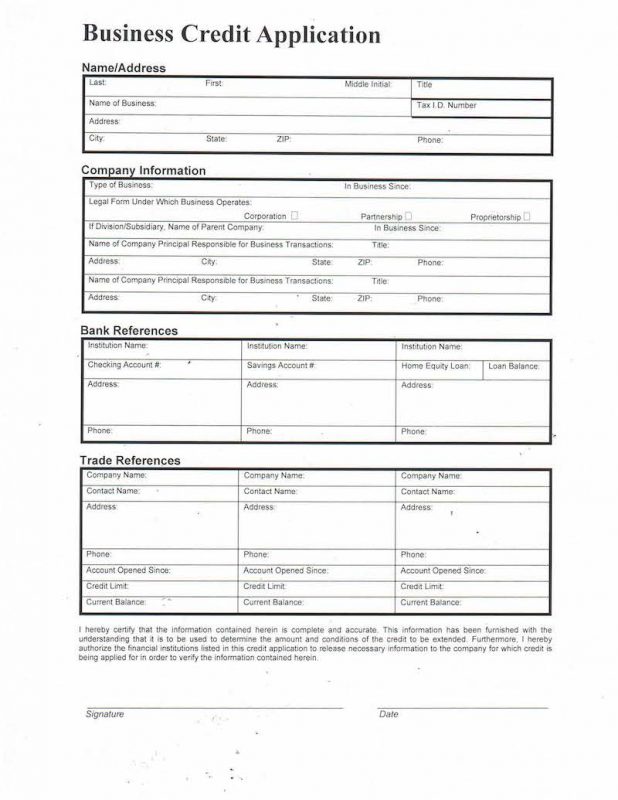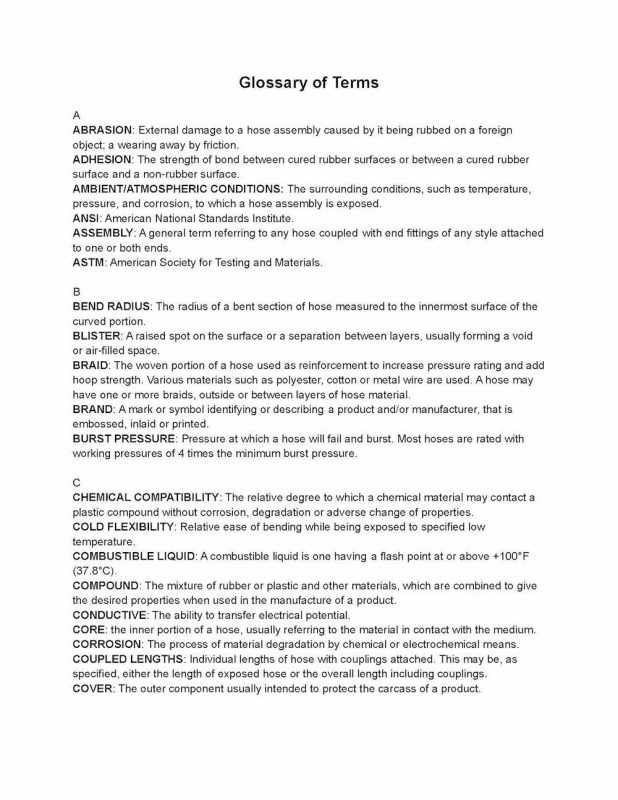Glossary of Terms
A
ABRASION: External damage to a hose assembly caused by it being rubbed on a foreign object; a wearing away by friction.
ADHESION: The strength of bond between cured rubber surfaces or between a cured rubber surface and a non-rubber surface.
AMBIENT/ATMOSPHERIC CONDITIONS: The surrounding conditions, such as temperature, pressure, and corrosion, to which a hose assembly is exposed.
ANSI: American National Standards Institute.
ASSEMBLY: A general term referring to any hose coupled with end fittings of any style attached to one or both ends.
ASTM: American Society for Testing and Materials.
B
BEND RADIUS: The radius of a bent section of hose measured to the innermost surface of the curved portion.
BLISTER: A raised spot on the surface or a separation between layers, usually forming a void or air-filled space.
BRAID: The woven portion of a hose used as reinforcement to increase pressure rating and add hoop strength. Various materials such as polyester, cotton or metal wire are used. A hose may have one or more braids, outside or between layers of hose material.
BRAND: A mark or symbol identifying or describing a product and/or manufacturer, that is embossed, inlaid or printed.
BURST PRESSURE: Pressure at which a hose will fail and burst. Most hoses are rated with working pressures of 4 times the minimum burst pressure.
C
CHEMICAL COMPATIBILITY: The relative degree to which a chemical material may contact a plastic compound without corrosion, degradation or adverse change of properties.
COLD FLEXIBILITY: Relative ease of bending while being exposed to specified low temperature.
COMBUSTIBLE LIQUID: A combustible liquid is one having a flash point at or above +100°F (37.8°C).
COMPOUND: The mixture of rubber or plastic and other materials, which are combined to give the desired properties when used in the manufacture of a product.
CONDUCTIVE: The ability to transfer electrical potential.
CORE: the inner portion of a hose, usually referring to the material in contact with the medium.
CORROSION: The process of material degradation by chemical or electrochemical means.
COUPLED LENGTHS: Individual lengths of hose with couplings attached. This may be, as specified, either the length of exposed hose or the overall length including couplings.
COVER: The outer component usually intended to protect the carcass of a product.
CRIMP/CRIMPING: A hose end fitting attachment method utilizing a number of dies mounted in a radial configuration. The dies close perpendicular to the hose and fitting axis, compressing the collar, ferrule, or sleeve around the hose.
D
DATE CODE: Any combination of numbers, letters, symbols or other methods used by a manufacturer to identify the time of manufacture of a product.
DESIGN FACTOR: A ratio used to establish the working pressure of the hose, based on the burst strength of the hose.
DUROMETER: The hardness of rubber and plastic compounds.
E
ELASTOMER: Any one of a group of polymeric materials, usually designated thermoset, such as natural rubber, or thermoplastic, which will soften with application of heat.
ELONGATION: The increase in length expressed numerically as a percentage of the initial length.
EXTRUDE/EXTRUDED/EXTRUSION: Forced through the shaping die of an extruder; extrusion may have a solid or hollow cross section.
F
FDA: United States Food and Drug Administration.
FLOW RATE: A volume of media being conveyed in a given time period.
H
HEAT RESISTANCE: The property or ability to resist the deteriorating effects of elevated temperatures.
HELIX: A shape formed by spiraling a wire or other reinforcement around the cylindrical body of a hose; typically used in suction hose.
HOSE: A flexible conduit consisting of a tube, reinforcement, and usually an outer cover.
HYDROSTATIC TESTING: the use of liquid pressure to test a hose or hose assembly for leakage, twisting, and/or hose change-in length.
I
I.D.: The abbreviation for inside diameter.
INNERTUBE: The innermost layer of a hose; the hose material in contact with the medium.
ISO: International Organization for Standardization.
K
KINKING: A temporary or permanent distortion of the hose induced by bending beyond the minimum
L
LAYLINE: The line of printed information that runs parallel on the side of a manufactured hose giving details such as part number, PSI rating, hose size and manufacturing data.
M
MEDIA, MEDIUM: The substance(s) being conveyed through a system.
MINIMUM BEND RADIUS (MBR): Minimum radius to which a hose may be bent without compromising the integrity of construction.
MSDS: Material Safety Data Sheet.
MSHA: Mine Safety and Health Administration.
N
NON-CONDUCTIVE: The inability to transfer an electrical charge.
NSF: National Sanitation Foundation.
NYLON: a family of polyamide materials.
O
O.D.: The abbreviation for outside diameter.
OIL RESISTANCE: The ability of the materials to withstand exposure to oil.
OPERATING CONDITIONS: The pressure, temperature, motion, and environment to which a hose assembly is subjected.
OZONE RESISTANCE: The ability to withstand the deteriorating effects of ozone (generally cracking).
P
PERMEATION: The process of migration of a substance into and through another, usually the movement of a gas into and through a hose material; the rate of permeation is specific to the substance, temperature, pressure and the material being permeated.
PIN PRICKED: Perforations through the cover of a hose to vent permeating gases.
PSI: pounds of pressure per square inch of area (lb2/in).
PVC: Polyvinyl chloride. A low cost thermoplastic material typically used in the manufacture of industrial hoses. The operating temperature range is -500°F to +1750°F (-295.5°C to +954.4°C).
R
RMA: The Rubber Manufacturers Association, Inc.
S
SAE: Society of Automotive Engineers.
SAFETY FACTOR: Divisor of burst pressure used to determine working pressure.
SPECIFICATION: A document setting forth pertinent details of a product.
SPIRAL: A method of applying reinforcement in which there is not interlacing between individual strands of the reinforcement.
STATIC WIRE: A wire incorporated in a hose to give quality or additional power to conducting or transmitting static electricity.
T
TUBE: The innermost continuous all-rubber or plastic element of a hose.
TUBING: A non-reinforced, homogeneous conduit, generally of circular cross-section.
U
UL: Underwriters’ Laboratories, Inc.
V
VACUUM: Full vacuum is 29.92 in Hg.
W
WORKING PRESSURE (WP): Maximum pressure at which a hose is designed to operate.
WORKING TEMPERATURE: The temperature range of the application, may include the temperature of the fluid conveyed or the environmental conditions the assembly is exposed to in use.
Y
YARN: A generic term for a continuous strand of textile fibers or filaments in a form suitable for knitting, weaving, or otherwise intertwining to form a textile fabric. It may comprise (a) a number of fibers twisted together, (b) a number of filaments laid together without twist (a sertwist yarn), (c) a number of filaments laid together with more or less twist, or (d) a singe filament with or without twist (a monofilament).



